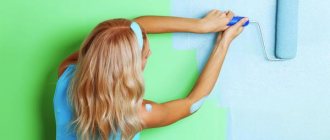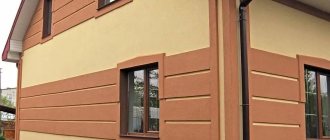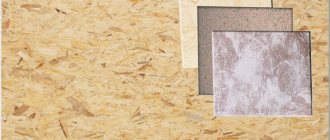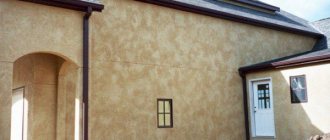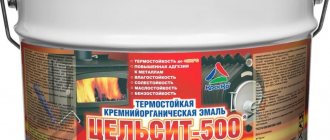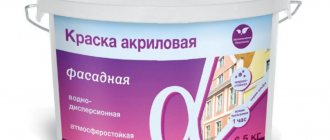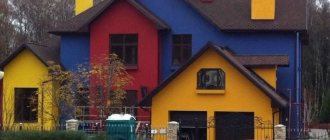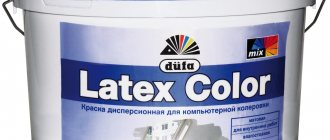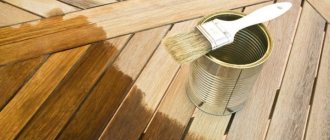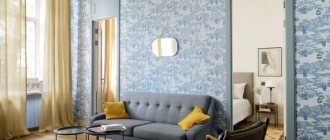Frame house-building technology allows you to build comfortable housing quickly and inexpensively. The external walls of such a building are covered with OSB boards, which, unfortunately for all developers, do not have the aesthetic appeal required for the facade. Therefore, it is necessary to purchase material for cladding the house, which leads to higher construction costs.
Facade made of OSB boards
Manufacturers of paints and varnishes have taken into account the need of developers for finishing OSB boards and are offering their own solutions to this issue. Craftsmen who know how to create masterpieces from any material did not stand aside either. Thanks to these folk craftsmen, creative solutions for the exterior decoration of a frame house appeared.
Methods of decorative coating of OSB panels
Features of OSB boards
Production of OSB boards
Oriented strand boards (OSB) consist of several layers of chips and shavings pressed and glued together. A feature of the manufacturing technology of these types of panels is that the chips in the layers are located in different directions. This provides the material with high bending strength and allows it to securely hold the fastener. On the outer layers of the panel, the chips are located along the surface, on the inner layers - across.
Classification of OSB boards
But despite the longitudinal direction of the wood component, the front side of the panel does not have the smoothness necessary for high-quality painting. Both sides of the OSB board are uneven and rough. This feature has its pros and cons. The advantage is that the lack of smoothness allows you to get a surface with a spectacular texture. The disadvantage is the need for additional processing of the slab with various tools and materials.
The market offers several brands of oriented strand panels: OSB-1, OSB-2, OSB-3 and OSB-4. The latter are intended for front finishing and have a fairly smooth and effective surface. But in the construction of frame houses, OSB-3 is most often used, since it is cheaper and has all the necessary characteristics for constructing walls. However, the surface of OSB-3 boards needs to be improved.
OSB - oriented strand boards
Since this material is most popular among developers, all the finishing methods proposed below take into account the peculiarities of the surface of these panels and can be applied to products of other brands: OSB-1 and OSB-2.
Prices for OSB (oriented strand boards)
OSB (oriented strand board)
Briefly about the material
Oriented strand board (OSB) consists of 90% natural wood in the form of large chips.
Crushed wood chips are joined together by gluing with different types of resins, polymers and adhesives. The result is a dense and hard material. But, as you know, natural wood is afraid of moisture and can swell under its influence. To protect the boards, they are impregnated with various chemical impregnations. The marking of the slabs depends on the type of impregnation used. Surely you noticed that the abbreviation OSB also has a number in the name. What does it mean?
- OSB-1 – has a minimum level of moisture-proof impregnations in its composition, therefore it is suitable for use only in dry, heated rooms.
- OSB-1 can withstand only short-term and minor exposure to moisture;
- OSB-2 – intended for finishing indoors with an average level of humidity;
- OSB-3 – able to withstand high levels of humidity, and even short-term wetness;
- OSB-4 is the most moisture-resistant category of material. Recommended for outdoor use.
Choosing a method for painting OSB boards
Choosing a method for painting OSB boards
Transparent coatings
Painting is the most inexpensive way to give panels an aesthetic appeal. Many developers like the texture of the slabs, which they would like to preserve. The unevenness of the surface of the panels when the sun's rays fall creates a certain play of light and shadow. It is this effect that is most attractive in untreated OSB.
In order to preserve and enhance it, use transparent paint with an ultraviolet filter. For example, Cetol Filter 7 Plus. This composition is intended for exterior wood finishing and is made on the basis of alkyd resins. The coating is transparent and has a semi-matte finish. The paint contains a UV stabilizer and water repellents, which provide reliable protection of wood from environmental influences.
Cetol Filter 7 Plus
If there is a need to preserve the natural texture of the slabs, you can use the following materials:
- clear varnishes;
- azure;
- transparent impregnations for wood.
Glazes are the most effective, as they have the ability to emphasize the grain of wood and give the painted surface a stylish shade and silky shine. A wide selection of these compositions is offered by the manufacturer BELINKA, whose assortment includes the “Toplazur” line, which includes 66 colors and shades.
Belinka Toplasur
Transparent wood varnishes will add gloss to the surface of the slab. You can use oil-based, water-based or organic-based formulations. Acrylic varnish will reliably protect the wood, and yacht varnish will give it a beautiful shade. An inexpensive and practical solution is semi-matte transparent “Drevolak”, designed for coating untreated wood and brick. This composition is easily applied to OSB and fills all its unevenness.
Drevolak - water-based acrylic varnish for wood protection
Prices for various types of construction varnishes
Construction varnishes
Tinting OSB boards
To emphasize the texture of OSB, you can use stain. To obtain the desired shade, it is diluted either with water, or with a solvent or acetone.
Shades of stains
The technique for painting OSB with stain is as follows:
- apply paint using a paint brush or spray gun;
- give time to dry (when diluting the stain with a solvent or acetone, the drying time is 5-7 minutes);
- Apply polyurethane primer to a dry painted surface and wait for it to dry.
Tools for applying stain to wood
In the photo - OSB board decorated with stain
To obtain the effect of artificial aging, use a patina of the desired color. After it dries, sand the slab with a soft foam sponge, which allows you to remove any remaining patina. After which the patinated panel is coated with transparent varnish.
Gold patina paint for wood
Prices for different types of stains
Stains
Covering enamels
In order to completely hide the protrusions of chips, thick covering enamels and water-soluble paints are used. The choice is wide:
- silicone;
- alkyd;
- pentaphthalic (forming a dense smooth film);
- acrylic (water soluble);
- latex.
Oil paint for wood
Oil paints have the highest viscosity. Their advantage is that they are practically not absorbed into the slab. Therefore, paint consumption is relatively low. The disadvantage of these compositions is the long drying time. But they have the main advantage: a durable covering layer and good adhesion to the surface, which is important when painting OSB. However, oil paints are not recommended for external use due to their instability to moisture and ultraviolet radiation.
Tikkurila Oil paint TECHO
Alkyd paints meet all requirements for painting facades. These compositions form a thin polymer film on the treated surfaces, which is moisture resistant and does not change its color when exposed to sunlight. Alkyd enamels can withstand significant temperature changes, therefore they are recommended for use in regions with any climate.
Range of alkyd coatings
Silicone paints are one of the most expensive. This is the main reason for their low popularity. This is despite the fact that silicone enamels fully comply with all the requirements for facade work. These paints have good resistance to mechanical stress, are crack-resistant and moisture-repellent. These compounds can be applied to OSB boards that have already been painted or whitewashed.
Facade silicone paint
Latex paints have high moisture resistance, so they are the best choice for regions with a maritime climate. Due to their excellent covering ability, they are not demanding on the quality of surfaces, which is especially important when finishing OSB boards. Facade latex paints can withstand a significant number of freeze-thaw cycles.
Latex water-based paint
The optimal choice for painting OSB is acrylic facade paints . They are inexpensive and have a lot of advantages: moisture resistant, withstand sudden temperature changes, vapor permeable, resistant to UV rays (do not fade in the sun). Acrylic paints can be applied at any time of the year. But in winter the air temperature should not be lower than -20°C.
Facade paint
Facade acrylic paint Ceresit CT 42
Prices for facade acrylic paints
Facade acrylic paints
Fire protection of OSB boards
The OSB board burns with the release of caustic substances, including toxic hydrocyanic acid. In the event of a fire, smoke is the decisive factor for survival. Using Soppka paints, you can solve two important problems at once: painting the panel and increasing its fire resistance several times.
Soppka - experts in OSB protection
Soppka compositions and paints are designed specifically for finishing oriented strand boards, so the manufacturer takes into account all the features of the surfaces of this material. The company's products have excellent adhesion to OSB, which cannot be said about other fire retardant compounds. The service life of Soppka coatings is more than 15 years. Paints can withstand any environmental influences.
Prices for various types of fire protection
Fire protection
Conclusion
OSB can be painted with any high-quality facade paint designed for fire protection of wooden surfaces. Good reviews about "Valtti Color Satin" from "Tikurilla". This enamel has excellent covering ability, does not change its color when exposed to sunlight, prevents wood from rotting, and has a noble matte finish.
Valtti Color Satin
Tikkurila Vallty Color Satin
If you decide to give the OSB surface an ideal smoothness, additional processing will be required, including grinding, priming, and impregnation with an antiseptic. All these points have many nuances that you need to know about to get the desired result. Therefore, it is better to consider painting OSB boards using specific examples of the use of various finishing options for these panels.
Why do you need painting?
OSB boards are painted for many reasons.
- Firstly, a layer of paint forms a stable, dense film on the surface, which provides additional protection from exposure to excess moisture and ultraviolet rays;
- Secondly, some coloring compositions have a fairly dense texture, which allows you to completely smooth out the uneven surface of the slabs. Not many people like the pristine appearance of this finishing material;
- Thirdly, painting is the most cost-effective way to protect and decorate the surface of OSB boards. Often this reason plays a decisive role.
Preparing OSB boards for painting
OSB requires preparation before painting
Before painting, the oriented strand panels are prepared. First of all, they need to be primed. This is not as simple a task as it might seem at first glance. The fact is that the front surface of the new slabs is smooth and quite slippery, so the primer will collect in drops and flow down. For this reason, experts recommend not to waste time and money on priming new slabs, but to immediately begin filling or painting them.
Panels that have stood in the open air for some time lose the smoothness of their front side. The surface becomes rough and able to absorb primer. The composition is applied with a roller on a long handle. The optimal choice is the Ceresit ST17 primer, the quality of which has been tested by time.
Primer ST 17
Prices for Ceresit primer
Primer Ceresit
Technique for painting OSB boards
When applying paint with a brush or roller, you may notice that some chips swell from moisture and rise. This happens regardless of the type of composition chosen. If you need a budget solution for finishing the facade, you can ignore these small shortcomings.
But if you intend to complete all the work with the highest possible quality, you need to adhere to the following technique:
- priming the panel;
- installation of fiberglass mesh over the entire façade area;
- puttying with a moisture-resistant and frost-resistant composition;
- coloring.
When choosing elastic paints (for example, Descartes or Emarque), the puttying step can be skipped. These paints will fit perfectly on the mesh and cover it. After applying the second layer, the OSB will acquire a smooth, glossy surface.
Decoration
OSB can not only be painted, but also decorated.
- Paint with an aged effect. The result is achieved thanks to acrylic varnish, coated with patina with an airbrush. After applying the varnish, the surface must be thoroughly sanded.
- Decoration with primer paint. It is applied to OSB facades with a fur roller.
- Gluing liquid wallpaper. Thus, it is possible to reduce the emission class of OSB and extend the service life of the finishing layer.
- Application of decorative plaster. This layer creates relief, patterns and all kinds of images on OSB.
- Forming bas-reliefs from polyurethane foam or putty mixture on slabs.
- Wall cladding with flexible stone.
Decoration options are presented in the images below.
You can achieve the original appearance of a building if you initially form a textured pattern from the slabs. And then give it the desired shade with paint, stain or epoxy.
OSB painting with artificial aging effect
This method of processing OSB panels allows you to preserve the surface texture while smoothing out the most noticeable chip protrusions. The end result is a smooth slab, on which its natural pattern is clearly visible. Using multi-layer dyeing with compositions of different colors and purposes, they provide two stylish effects at once: colored dyeing and artificial aging.
Tools and materials that will be required to complete the work.
- Angle grinder (grinder).
- Abrasive grinding wheels of different grain sizes: P180 and P320. You can use modern abrasive Velcro tapes, one side of which is self-adhesive.
- Abrasive sponge P320.
Abrasive sponge fine grain P 280-P320
- Airbrush or spray gun.
- Primers: FI M194 and FL M042/CO2.
Primer FL-M042/C02 Renner
- Acrylic varnish “Mother of Pearl” JW M120.
- Tinted varnish JO 00M294.
- Patina GM M048/Black.
Stages of painting OSB boards
Step 1: Sanding the panel.
Smooth out uneven surfaces of the panel using a grinder and a P180 grinding wheel. To obtain the desired result, work with light pressure from the tool. The panels are passed over each section with an abrasive wheel no more than three times.
Sanding OSB
Step 2: Apply the first coat of primer.
OSB boards are made using a special adhesive impregnation, which includes various resins, wax and paraffin. These substances are necessary to prevent the panel from delaminating and the formation of rot and mold in it.
Primer for OSB
Applying primer
A primer on the sanded OSB surface is needed to ensure that the resins and paraffin continue to remain inside the slab. At this stage of work, barrier primer FI M194 is used. It is applied using an airbrush or spray gun. Material consumption is within 50-60 g/m2. Further work begins after 1.5-2 hours, after the soil has completely dried.
Step 3. Applying pigment primer.
At this stage of the work, the panel is covered with primer FL M042/CO2. This is a matte white composition that dries within 2.5-3 hours. The soil consumption should be at least 100 g/m2.
Step 4: Sanding the slab.
Use a grinder with a P320 abrasive wheel. Only the top layer of pigment primer is removed. The result should be a smooth whitish matte surface.
Primed surface
Step 5. Varnishing the slab.
Acrylic varnish “Pearl” JW M120 is applied to the OSB so that the weight of the wet layer is 100-120 g/m2. In order to achieve this result, each section of the panel must be covered with 2-3 layers of varnish. Then wait for the coating to dry completely for an hour.
Step 6. Patination.
At this stage of work, black patina GM M048 is applied to the panel. As before, an airbrush or spray gun is used for this purpose. The weight of the wet layer should be 60-80 g/m2. There should be no gaps in the panel from the previous white layer. The patina dries within 5-7 minutes.
Patina for wood Renner GM M048/C01
Step 7. Patina sanding.
Using light pressure, sand the panel with a P320 abrasive sponge. After such processing, you should get a surface with a clear chip pattern, the main part of which is white, and the spaces between the chips are black. This provides an artificial aging effect.
Remove excess patina with a sponge
Step 8. Tinting the OSB board.
Tinting is the stage as a result of which the slab acquires color. To perform this task, acrylic varnish is used. The color is chosen depending on how you want the facade of your house to look. Varnish consumption is within 100-120 g/m2. Drying time according to the manufacturer's instructions, but on average 1.5-2 hours.
Acrylic lacquer
It should be noted that as the varnish dries, its color will change due to the gradual acquisition of dullness. This example uses JO 00M294 zero gloss varnish. If you want to give the façade of your home a glossy look, you can opt for compounds that provide this effect.
Example of applying varnish with a brush
Technology of painting OSB with primer-paint
This method of painting oriented strand boards was developed by Holzer specifically for finishing the facades of frame buildings. Therefore, the instructions offered by the manufacturer use exclusively its products.
Tools and materials required to perform the work.
- A spatula with a narrow metal blade.
- Holzer Festspachtel Elastich putty.
Putty Holzer Festspachtel Elasticch
- Holzer primer color.
Holzer primer color
- Roller for applying paint (with a foam or faux fur coat).
- Container (tray) for paint.
If desired, you can use narrow decorative panels, with the help of which you can decorate the façade in the half-timbered style.
Finish example
Instead of plastic panels, you can attach thin wooden blocks, pre-treated with an antiseptic and painted in a color that harmonizes with the finish of the facade.
Stages of work
Step 1. Puttying the seams between OSB boards.
Holzer Festspachtel Elastisch putty is applied to the seams between OSB boards. Use a spatula to press the compound into the gaps and spread the putty at a distance of 5-7 cm from the seams. They strive to smooth out the composition in such a way as to obtain a smooth surface without visible cracks. Wait for the composition to harden.
Puttying
Step 2: Painting the panel.
Using a roller, Holzer primer is applied to the slab.
Application of primer
The soil dries in about 6 hours
You can choose any color from the manufacturer’s catalog (there are more than 7 thousand colors in stock). If a fur roller is used, it must first be kept in water for 1.5-2 hours. If a bucket is chosen as a container for paint, you need to prepare a small piece of plywood on which to roll out the roller, removing excess paint from its coat.
Coloring technique:
- paint is poured into the container;
- dip the roller in paint and roll it several times over a special part of the tray or plywood;
- Apply paint to the wall so that each next layer overlaps the previous one by 4-5 cm.
Holzer paints have good covering power, so even surfaces do not require a double coat. But in the case of OSB, it will be necessary to properly paint all the protrusions and recesses. Therefore, the manufacturer recommends painting with vertical strokes on the first day of work, and horizontal strokes on the second day. In this case, the coating will acquire the thickness and strength necessary for facades.
Video - Creative finishing of OSB boards
How to choose the right tools for working inside a building
There are more stringent requirements for painting OSB boards indoors. Many types of paints and varnishes, which are based on polymers, can be harmful to health.
Stain and varnish
Such products are used only in cases where they want to emphasize the structure of the surface. It is covered with stain with a patina effect, and then a varnish based on polyurethane or vinyl is applied.
Acrylic based products
With this paint you can achieve a uniform texture. This composition is convenient for covering not only walls, but also floors.
Wait for good weather to work outside the building Source krrot.net
See also: Catalog of companies that specialize in finishing materials
Glazing azures
Such transparent and thin paints for OSB for interior work are produced on the basis of acrylic or alkyd substances. They give the material the necessary shade and help preserve the structure. If the glaze contains alkyd substances, it should be used only for exterior work, while acrylic-based compositions are used for all types of work. There are special azures for OSB. Products for working outside the building must be resistant to solar radiation. Such information is indicated on the label or instructions.
In some cases, it is preferable to leave the surface in its original color, for which transparent varnish is ideal Source remont.adstores.ru
Stain is used to emphasize the structure of the material Source gidpokraske.ru
